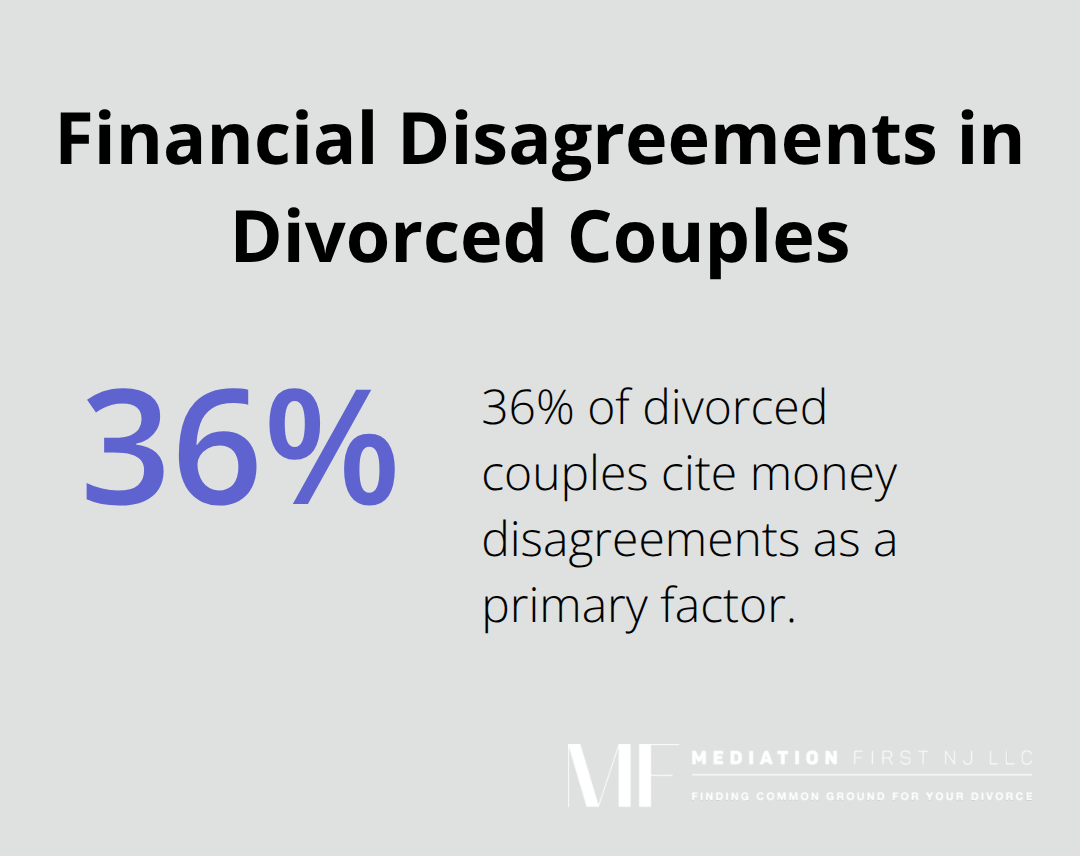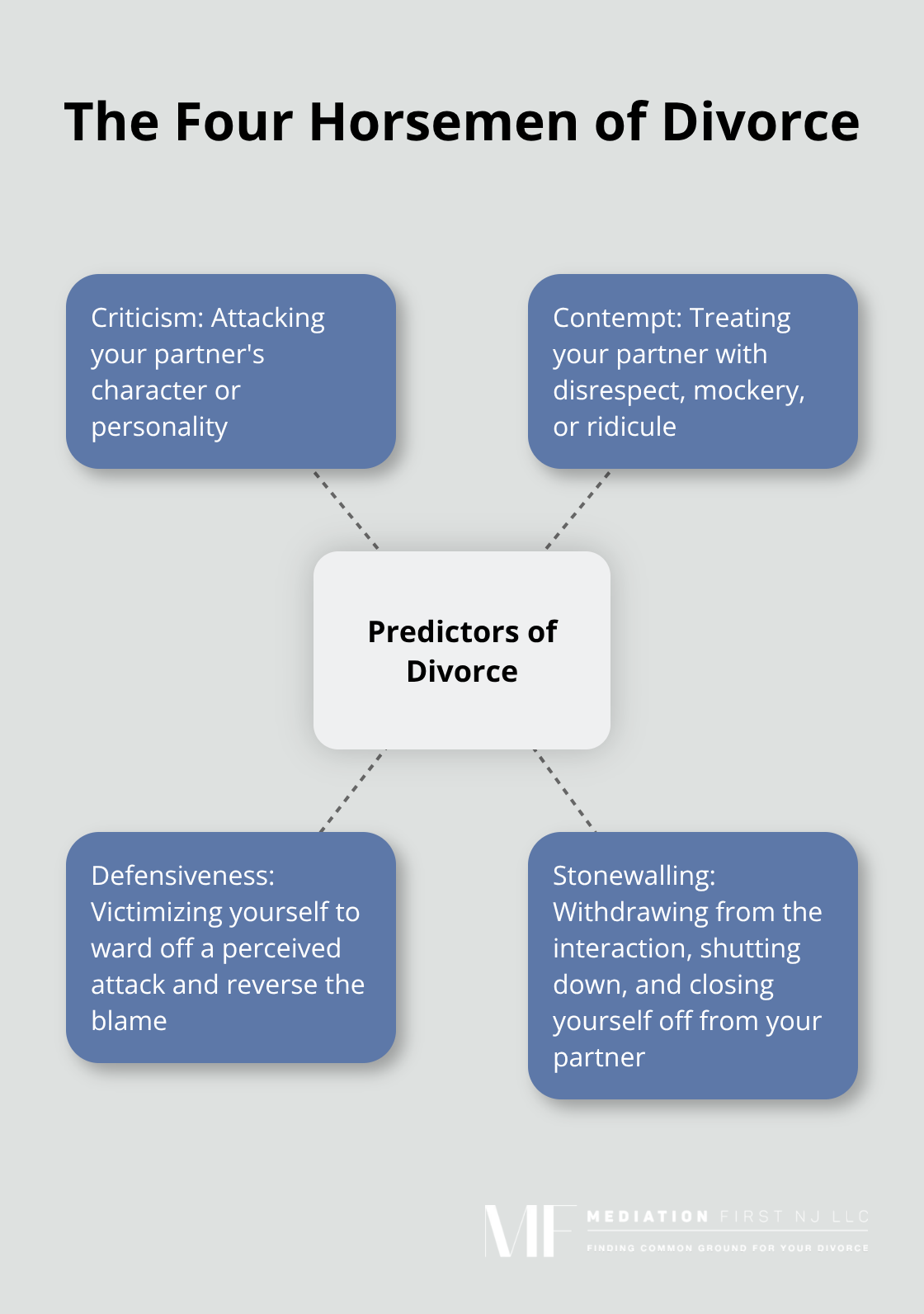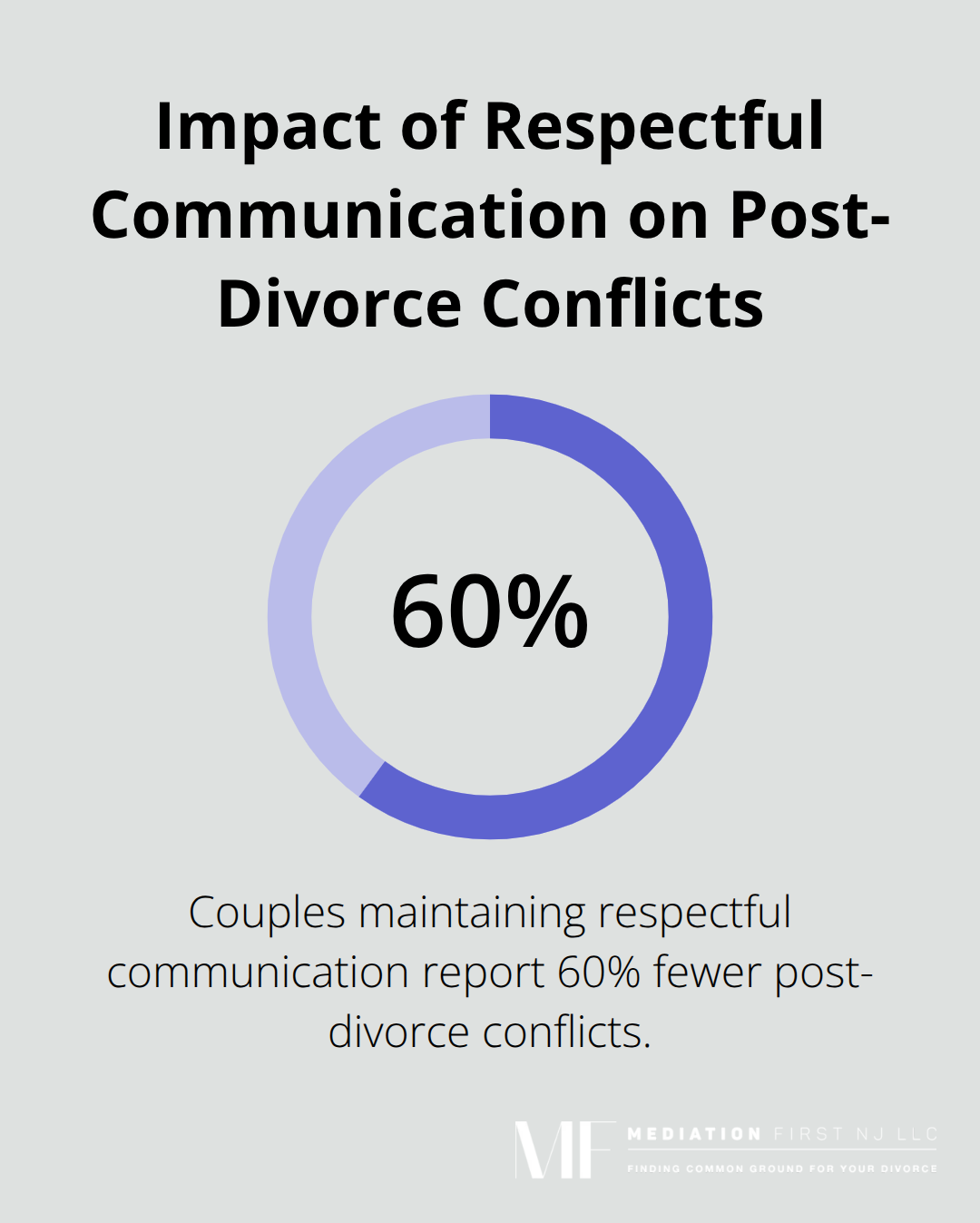Relationship dynamics shift dramatically when couples face the possibility of divorce. What starts as minor disagreements often escalates into patterns that can make or break the entire process.
We at Mediation First NJ LLC see how these changing dynamics directly impact both the divorce proceedings and the family’s future. The way couples communicate and interact during this time shapes everything from settlement negotiations to their children’s wellbeing.
What Warning Signs Appear Before Divorce
The transformation from a healthy marriage to divorce rarely happens overnight. Research from the University of Washington shows that couples typically experience relationship deterioration for an average of six years before they file for divorce. Women report that they recognize an average of 10.7 problems that contribute to their divorce, while men identify only 7.8 problems according to studies by Amato and Previti. This data highlights how differently partners perceive relationship decline.
Daily Conversations Turn Into Arguments
Communication breakdown follows predictable patterns that couples can identify early. The Gottman Institute research identifies four communication patterns that predict divorce with 94% accuracy: criticism, contempt, defensiveness, and stonewalling. Couples who engage in these behaviors during disagreements see their conflicts escalate rather than resolve. Financial discussions become particularly volatile,

with 36% of divorced couples who cite money disagreements as a primary factor according to the National Center for Health Statistics. Simple conversations about budgets, spending, or financial goals transform into accusations and blame sessions. Partners stop sharing daily experiences and begin to withhold information to avoid conflict.
Physical and Emotional Withdrawal Accelerates
Emotional withdrawal creates a cycle of disconnection, misunderstanding, and resentment that impacts relationships profoundly. Partners create separate bedrooms, avoid physical contact, and stop expressing affection. Work schedules become convenient excuses to avoid home time, and social events become individual rather than couple activities. This withdrawal creates a cycle where partners feel increasingly isolated within their own marriage, which makes reconciliation more difficult as emotional investment decreases.
Trust Issues and Secrecy Develop
Partners begin to hide financial information, personal communications, and daily activities from each other. Phone passwords appear where none existed before, and credit card statements become sources of suspicion rather than shared financial planning tools. Social media activity shifts to exclude the spouse, and friends receive information that partners no longer share with each other. These secretive behaviors create additional barriers to open communication and fuel existing trust issues that already strain the relationship.
These warning signs often compound each other, creating momentum toward more serious relationship problems that require professional intervention to address effectively.
How Do Dynamics Shift During Divorce Proceedings
Once divorce papers are filed, relationship dynamics become more intense and unpredictable. The legal process creates new pressures that transform how couples interact, often revealing behaviors that surprise even the partners themselves. Duke University research shows that women face a 24% increased risk of heart attack after their first divorce, while men experience greater mortality rates compared to married men, which demonstrates how the stress of divorce proceedings affects both parties physically and emotionally.

Control Battles Replace Cooperative Decision Making
Divorce proceedings trigger power struggles over assets, schedules, and children that rarely existed during the marriage. Partners who once shared household decisions now fight over who gets the coffee maker or controls the thermostat. Financial accounts become weapons rather than shared resources, with one spouse who freezes credit cards or hides bank statements to gain leverage. Couples argue over pickup times for children not because of schedule conflicts, but because each parent wants to demonstrate control over the other’s access. These battles waste emotional energy and legal fees while they create permanent resentment that affects post-divorce relationships. Depression affects more than 8% of American adults each year, and rates increase during active divorce proceedings, partly due to these exhausting control conflicts that leave both parties defeated.
Children Experience Loyalty Conflicts and Emotional Stress
Parents often unconsciously recruit children as allies, ask them to carry messages between households, or share information about the other parent’s activities. Children report that they feel responsible for their parents’ emotions and guilty when they enjoy time with one parent over the other. Research from the Child Welfare Information Gateway shows that children whose parents engage in high-conflict divorce proceedings exhibit more behavioral problems and academic difficulties compared to children whose parents maintain cooperative communication.
External Influences Intensify Family Conflicts
Friends and extended family members intensify these dynamics when they take sides, offer unsolicited advice, and sometimes encourage more aggressive legal strategies. Grandparents may withhold support from one side while they increase involvement with the other, which creates additional stress for children who lose relationships they previously counted on for stability. Social media becomes another battleground where family members post subtle (or not-so-subtle) messages of support for one spouse over the other.
These intensified dynamics during divorce proceedings directly influence how settlement negotiations unfold and whether couples can reach agreements that serve their family’s long-term interests. Mediation offers flexibility that traditional court processes lack, allowing couples to maintain more control over their outcomes while reducing the adversarial nature of these proceedings.
How Relationship Dynamics Shape Divorce Costs
The way couples communicate during divorce directly determines their financial and emotional costs. Hostile communication patterns drive up legal expenses while cooperative approaches save money and preserve family relationships. Research from the American Bar Association shows that high-conflict divorces cost significantly more than mediated divorces.
Hostile Communication Creates Expensive Legal Battles
Couples who use criticism, contempt, and stonewalling during negotiations require more attorney hours to reach agreements. Each hostile email exchange generates billable hours as lawyers translate aggressive language into legal positions. The Journal of Family Issues found that couples who cannot communicate directly spend 40% more on legal fees because attorneys must handle all interactions.
Court battles escalate when partners refuse to negotiate directly, with some cases that require multiple hearings costing $3,000 to $5,000 each. Emotional volatility leads to impulsive decisions like rejection of reasonable settlement offers, which forces expensive trial preparation that benefits only the legal professionals involved.
Poor Communication Patterns Extend Legal Timelines
Attorneys spend additional hours when they must clarify hostile messages between spouses. Simple asset division discussions stretch into months when couples cannot agree on basic terms. Discovery processes become more expensive as each party demands extensive documentation to verify the other’s claims (often driven by mistrust rather than necessity).
Judges schedule additional hearings when couples present conflicting information or fail to follow court orders. These extended timelines increase costs exponentially while they delay resolution for everyone involved.
Cooperative Communication Reduces Long-Term Conflicts
Couples who maintain respectful communication during divorce report 60% fewer post-divorce conflicts according to research from the Association of Family and Conciliation Courts. Parents who avoid hostile exchanges create stable co-parenting relationships that benefit their children’s academic performance and emotional adjustment.
The BIFF method – Brief, Informative, Friendly, and Firm communication – helps divorced couples resolve scheduling conflicts without return trips to court. Cooperative approaches result in agreements that both parties understand and follow, which eliminates the need for costly enforcement actions.

These couples typically spend less than $15,000 total on their divorce process while they maintain relationships that support effective co-parenting for years afterward.
Final Thoughts
Relationship dynamics during divorce proceedings determine whether families emerge stronger or remain trapped in destructive patterns for years. Research shows that couples who recognize communication breakdowns early can prevent the escalation that leads to expensive legal battles and emotional damage. Professional mediation addresses these dynamics directly when it creates structured environments where couples learn to communicate without criticism, contempt, or stonewalling.
We at Mediation First NJ LLC guide families through this process when we foster constructive dialogue that prioritizes children’s wellbeing and long-term family stability. Mediation services provide the tools couples need to resolve disputes collaboratively rather than adversarially. This approach transforms how couples interact during their most difficult conversations.
The foundation for healthier post-divorce relationships begins during the divorce process itself. Couples who maintain respectful communication during negotiations report 60% fewer conflicts afterward (according to the Association of Family and Conciliation Courts). These families avoid the cycle of court returns that plague high-conflict divorces while they build the trust necessary for effective co-parenting that serves their children’s academic and emotional development.

